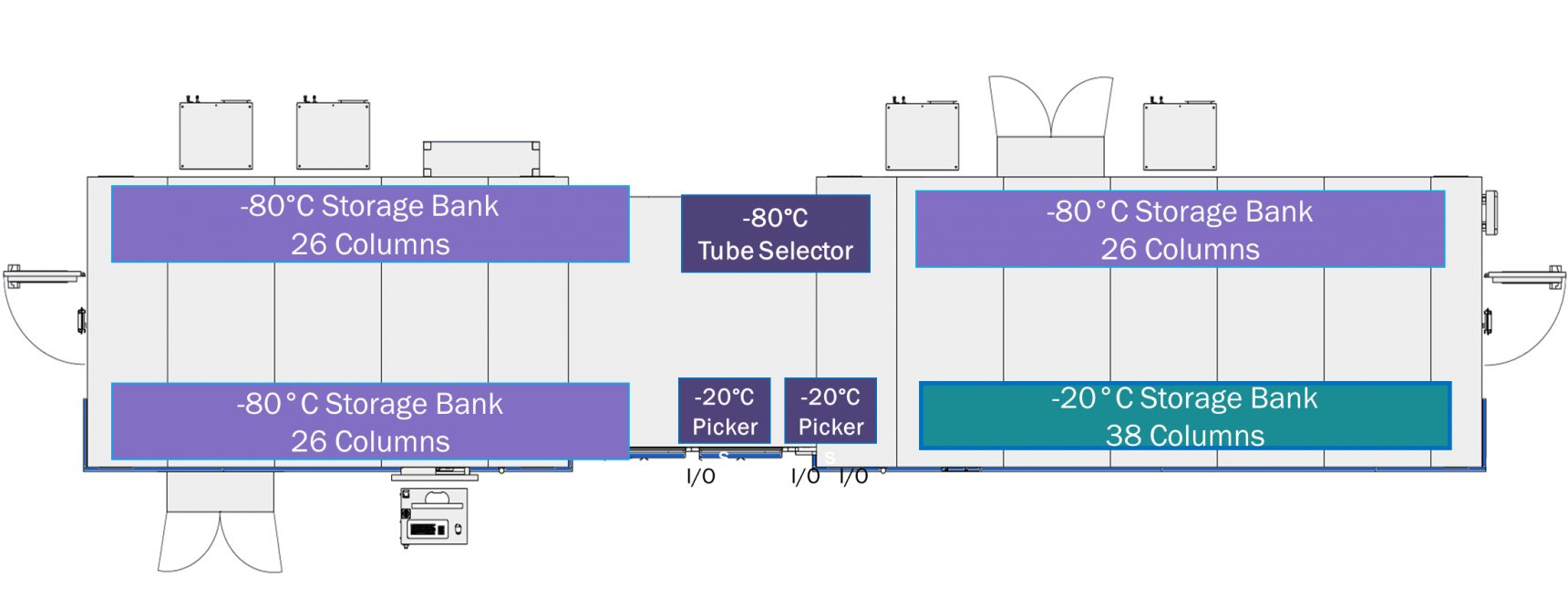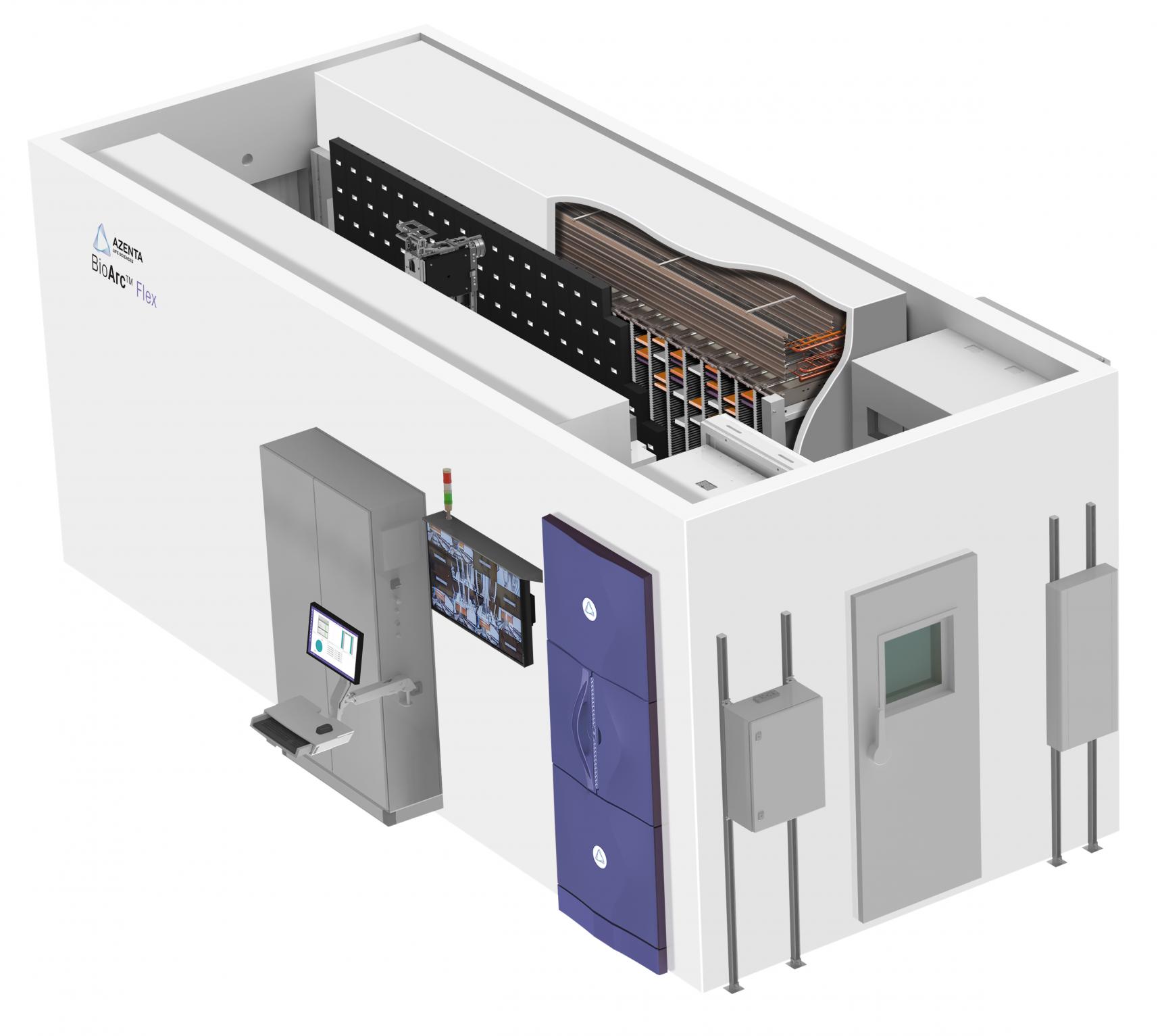Biobanking has become an essential part of biomedical research, providing researchers with access to valuable biological specimens for use in a wide range of studies. But as the scope and span of biomedical research grows, so does demand for advanced storage facilities capable of accommodating diverse biological specimens and liquid-based compounds used for clinical trials, drug discovery, and clinical diagnostics.
Dual Temperature Sample Storage
To meet these evolving demands, an innovative approach known as dual temperature sample storage has emerged, reshaping the landscape of biobanking. By offering distinct temperature zones within a single automated storage unit, dual temperature sample storage expands the possibilities for biobanks to preserve and provide access to a wide array of valuable biological (and non-biological) samples.
Over the past decade, the field of biobanking has experienced rapid growth, aligning with the advancements in precision medicine. Dual temperature automated sample storage offers biobanks, research centers, and drug discovery programs advantages that are both economical and practical by expanding the possibilities of their sample storage programs.
What Are Dual Temperature Sample Storage Systems?
Dual temperature sample storage systems are automated storage units that are capable of maintaining two different temperatures within the same enclosure. This is particularly useful for specimens that require different storage conditions. For example, some samples may need to be stored at a temperature of -80 degrees Celsius, while others may need to be stored at a temperature from ambient to -20 degrees Celsius.
Traditionally, these specimens would need to be stored in separate freezers, which can be incredibly space-intensive and difficult to manage. However, with dual temperature automated storage systems, both types of samples can be stored in the same enclosure, allowing for more efficient use of space and easier management of samples.
“Some companies that have biological samples also want to store compounds that use genetic material, DNA, or RNA,” said Dean Montano, Senior Product Manager, Automated Storage at Azenta. “But they may have space constraints or resource constraints that prevent managing two separate types of storage centers. A combined BioArc can support both -20°C and -80°C storage needs.”
Vanderbilt University Medical Center Biobank
Dual temperature automated sample storage for biobanks, like the one recently installed at Vanderbilt University Medical Center (VUMC), are unique in that they offer two separate storage temperatures within a single unit. This allows for the storage of a wide range of biological samples, from those that require freezing temperatures of -20°C to ultra-low -80°C storage. By providing researchers with access to a greater range of samples, dual temperature biobanks are helping to drive new discoveries and insights into human biology and disease.
The VUMC Biobank (BioVU) is a first-of-its-kind construction that integrates a unique dual temperature BioArc™ Duo system (formerly known as BioStore™). On one side, there is an automated sample storage system the accommodates -80°C, while the other side offers -20°C storage. These two temperature zones are separated by a tile wall. The specialized zones provide optimal preservation conditions for various samples, including cell and tissue samples, as well as RNA and DNA-based samples.
“Compared to the automated freezer that previously housed BioVU, [BioArc] offers a dramatic improvement in sample retrieval speeds and a notable decrease in error rates and downtime,” officials said. The VUMC dual temperature BioArc spans approximately 40 feet in length and 14 feet in height, and boasts redundant power and cooling systems, reinforcing sample integrity with multiple layers of protection.


Comparing -20°C and -80°C Storage Needs
Biobanks that utilize -20°C storage temperature play a crucial role in various research and clinical applications. One prominent application area is the preservation of biological samples for routine diagnostic testing. -20°C biobanks are commonly used for storing blood, urine, and other biofluid samples, allowing for easy access and retrieval when conducting routine laboratory tests.
These biobanks are particularly valuable in clinical settings where timely analysis of samples is necessary for diagnosing and monitoring diseases such as diabetes, kidney disorders, and infectious diseases. The accessibility and convenience of -20°C biobanks make them a practical choice for maintaining a wide range of samples that are frequently needed for routine testing.
On the other hand, biobanks utilizing -80°C storage temperature are essential for the long-term preservation of highly valuable and fragile biological materials. The ultra-low temperature of -80°C provides optimal conditions for storing delicate samples such as blood and RNA.

This type of biobank is commonly employed in research areas such as genomics, proteomics, and stem cell research. The extreme cold temperatures prevent degradation and maintain the integrity of samples over an extended period. -80°C biobanks are particularly valuable for storing samples that require long-term preservation and future analysis, enabling scientists to conduct in-depth studies and investigations into genetic and molecular components, advancing our understanding of diseases, and facilitating the development of innovative therapies.
Why Use Dual Temperature Automated Storage for Biobanks?
Versatility and flexibility: With dual temperature capabilities, a biobank can accommodate a wide range of sample types, including those requiring ultra-low temperatures (such as -80°C) and samples that need higher temperatures (such as ambient to -20°C). This versatility enables the storage of diverse sample types within a single biobanking system, reducing the need for multiple storage units and simplifying the overall sample management process.
Diversity of samples: Dual temperature automated storage systems for biobanks provide separate storage compartments with different temperature settings. This allows for optimal preservation conditions for various sample types, ensuring their long-term viability and integrity. Different samples, such as DNA, RNA, proteins, and cells, may require different temperature ranges for optimal preservation, and a dual-temperature automated storage system can accommodate these specific requirements.
Cost and space efficiency: Consolidating sample storage into a dual temperature system minimizes the need for separate storage systems for different temperature requirements. This results in cost savings, as there is no need to invest in multiple automated sample storage systems. Additionally, it optimizes space utilization within the laboratory, making the most efficient use of limited storage areas.
Streamlined workflow: Having a single biobanking system with dual temperature compartments promotes a streamlined workflow. Researchers and clinicians can access samples with different preservation requirements from a central location, eliminating the need for separate storage areas, facilities, or processes. This improves operational efficiency, reduces sample retrieval time, and enhances overall productivity.
Sample security and traceability: Dual temperature automated storage systems often come equipped with advanced monitoring and security systems. These systems ensure precise temperature control, real-time monitoring, and alerts for any temperature deviations. Additionally, they offer robust sample tracking and management features, including sample inventory, user access control, audit trails, and chain-of-custody records. These features enhance sample security, traceability, and compliance with regulatory guidelines.
Looking ahead, the potential of dual temperature biobanks is enormous. As science and biotechnology continue to advance, the need for high-quality biological specimens will only increase. By investing in advanced facilities and technology, and by maintaining a commitment to ethical and responsible practices, biobanks like the one at Vanderbilt University Medical Center are helping to pave the way for a brighter future in biomedical research.
Automation Delivers Efficiency for Biobanks
Automated stores from Azenta Life Sciences offer a broad range of benefits, including flexibility and modularity, secure and accurate inventory control, optimization of customer workflows, and improved sample throughput across various applications.

References
- Annaratone, L., De Palma, G., Bonizzi, G. et al. Basic principles of biobanking: from biological samples to precision medicine for patients. Virchows Arch 479, 233–246 (2021). https://doi.org/10.1007/s00428-021-03151-0
- Müller, A., & Smith, J. (2019). Challenges in setting up and managing dual temperature biobanks. Journal of Biorepository Science for Applied Medicine, 5(2), 100-115. https://www.jbsam.org/articles/10.2147/JBSAM.S207048
- Thompson, R., & Davis, L. (2018). Practical considerations in establishing a dual temperature biobank for cancer research. Journal of Translational Medicine, 16(1), 150. https://translational-medicine.biomedcentral.com/articles/10.1186/s12967-018-1585-5
- Anderson, K., & White, S. (2017). Management challenges of dual temperature biobanks. Biopreservation and Biobanking, 15(4), 329-342. https://www.liebertpub.com/doi/10.1089/bio.2016.0115
- Johnson, M., & Wilson, C. (2020). Regulatory and ethical considerations in managing dual temperature biobanks for COVID-19 research. Journal of Clinical Medicine, 9(9), 2741. https://www.mdpi.com/2077-0383/9/9/2741/htm









